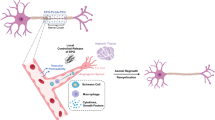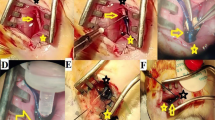Abstract
Purpose
Trauma-mediated peripheral nerve axon injury invariably involves structural alteration of the axonal plasmalemma cell membrane. Increased axonal membrane permeability to electrolytes results in metabolic stress and axonal degeneration if the axon does not seal. Poloxamer 188 (P188) is a linear multiblock copolymer composed of a hydrophobic polyoxypropylene (POP) block in the middle with polyethylene glycol (PEG) blocks on both ends. The central POP block concentrates at sites of cell membrane disruption and catalyzes sealing of disrupted cellular membranes. We tested the hypothesis that intravenously administered P188 (9800 Da, 0.2 mM) can accelerate distal axon recovery after sciatic nerve crush injury using an established axonotemetic model.
Methods
A crush injury was performed on the sciatic nerve of thirty female Sprague-Dawley rats. Rats were randomized to receive either 0.2 mM P188 or Dextran, administered 1 h after crush injury. Compound nerve action potentials (CNAP) and density of neurofilament distal to the point of injury were analyzed on post-crush day (PCD) 4, 14, and 21.
Results
A significant improvement in axonal conduction for animals treated with P188 was observed for PCD 4 and PCD 14 (p < 0.01). The segment of axon distal to the site of injury in the P188-treated group demonstrated significant increase in nerve fiber density on PCD4 (p < 0.01).
Conclusion
Therefore, a single dose of intravenous P188 administered 1 h after crush injury to rat sciatic nerve resulted in more rapid structural and functional nerve recovery.
Lay Summary
Nerve injuries are common in day-to-day physical trauma. On a molecular level, nerve injury is precipitated by damage to the nerve’s cell membrane, which disrupts the delicate balance of the cellular environment and leads to cell death. There are molecules that can repair ruptured cell membranes by inserting themselves into it and effectively resealing the cell. Copolymer P188 is one such molecules which can be injected intravenously and selectively targets injured cell membranes. In this study, we tested the hypothesis that copolymer P188 injected intravenously into rats following peripheral nerve injury could facilitate the functional recovery of the nerve.




Similar content being viewed by others
Data Availability
Not applicable.
References
Chen P, Piao X, Bonaldo P. Role of macrophages in Wallerian degeneration and axonal regeneration after peripheral nerve injury. Acta Neuropathol. 2015;130(5):605–18.
Ramaglia V, King RH, Nourallah M, Wolterman R, de Jonge R, Ramkema M, et al. The membrane attack complex of the complement system is essential for rapid Wallerian degeneration. J Neurosci. 2007;27(29):7663–72.
Ramaglia V, King RH, Morgan BP, Baas F. Deficiency of complement regulator CD59a exacerbates Wallerian degeneration. Mol Immunol. 2009;46(8–9):1892–6.
Coleman M. Axon degeneration mechanisms: commonality amid diversity. Nat Rev Neurosci. 2005;6(11):889–98.
Scheib J, Hoeke A. Advances in peripheral nerve regeneration. Nat Rev Neurol. 2013;9(12):668–76.
Zhelyaznik N, Mey J. Regulation of retinoic acid receptors alpha, beta and retinoid X receptor alpha after sciatic nerve injury. Neuroscience. 2006;141(4):1761–74.
Curry DJ, Wright DA, Lee RC, Kang UJ, Frim DM. Surfactant poloxamer 188 – related decreases in inflammation and tissue damage after experimental brain injury in rats. J Neurosurg. 2004;101(1 Suppl):91–6.
Serbest G, Horwitz J, Barbee K. The effect of poloxamer-188 on neuronal cell recovery from mechanical injury. J Neurotrauma. 2005;22(1):119–32.
Moloughney JG, Weisleder N. Poloxamer 188 (p188) as a membrane resealing reagent in biomedical applications. Recent Pat Biotechnol. 2012;6(3):200–11.
Pandanilam JT, Bischof JC, Lee RC. Effectiveness of poloxamer 188 in arresting calcein leakage from thermally damaged isolated skeletal muscle cells. Ann N Y Acad Sci. 1994;720:111–23.
Bridge PM, Ball DJ, Mackinnon SE, Nakao Y, Brandt K, Hunter DA, et al. Nerve crush injuries—a model for axonotmesis. Exp Neurol. 1994;127(2):284–90.
Laverty PH, Leskovar A, Breur GJ, Coates JR, Bergman RL, Widmer WR, et al. A preliminary study of intravenous surfactants in paraplegic dogs: polymer therapy in canine clinical SCI. J Neurotrauma. 2004;21(12):1767–77.
Wu G, Majewski J, Ege C, Kjaer K, Weygand MJ, Lee KY. Lipid corralling and poloxamer squeeze-out in membranes. Phys Rev Lett. 2004;93(2).
Hadlock TA, Heaton J, Cheney M, Mackinnon SE. Functional recovery after facial and sciatic nerve crush injury in the rat. Arch Facial Plast Surg. 2005;7(1):17–20.
Maskarinec SA, Hannig J, Lee RC, Lee KY. Direct observation of poloxamer 188 insertion into lipid monolayers. Biophys J. 2002;82(3):1453–9.
Bittner GD, Sengelaub DR, Trevino RC, Peduzzi JD, Mikesh M, Ghergherehchi CL, et al. The curious ability of ethylene glycol-fusion technologies to restore lost behaviors after nerve severance. J Neurosci Res. 2016;94(3):207–30.
Riley DC, Bittner GD, Mikesh M, Cardwell NL, Pollins AC, Ghergherehchi CL, et al. Polyethylene glycol fused allografts produce rapid behavioral recovery after ablation of sciatic nerve segments. J Neurosci Res. 2015;93(4):572–83.
Varejao AS, Cabrita AM, Meek MF, Bulas-Cruz J, Melo-Pinto P, Raimondo S, et al. Functional and morphological assessment of a standardized rat sciatic nerve crush injury with a non-serrated clamp. J Neurotrauma. 2004;21(11):1652–70.
Camera CI, Wilke N. Interaction of dextran derivates with lipid monolayers and the consequential modulation of the film properties. Chem Phys Lipids. 2017;204:34–42.
Curry DJ, Wright DA, Lee RC, Kang UJ, Frim DM. Poloxamer 188 volumetrically decreases neuronal loss in the rat in a time-dependent manner. Neurosurgery. 2004;55(4):943–8.
Quinn M, Mukhida K, Sadi D, Hong M, Mendez I. Adjunctive use of the non-ionic surfactant poloxamer 188 improves fetal dopaminergic cell survival and reinnervation in a neural transplantation strategy for Parkinson’s disease. Eur J Neurosci. 2008;27(1):43–52.
Murphy AD, McCormack MC, Bichara DA, Nguyen JT, Randolph MA, Watkins MT, et al. Poloxamer 188 protects against ischemia-reperfusion injury in a murine hind-limb model. PlastReconstrSurg. 2010;125(6):1651–60.
Frim DM, Wright DA, Curry DJ, Cromie W, Lee R, Kang UJ. The surfactant poloxamer-188 protects against glutamate toxicity in the rat brain. Neuroreport. 2004;15(1):17104.
Wang T, Chen X, Wang Z, Zhang M, Meng H, Gao Y, et al. Poloxamer-188 can attenuate blood-brain barrier damage to exert neuroprotective effect in mice intracerebral hemorrhage model. J Mol Neurosci. 2015;55(1):240–50.
Lee M, Doolabh VB, Mackinnon SE, Jost S. FK506 promotes functional recovery in crushed rat sciatic nerve. Muscle Nerve. 2000;23(4):633–40.
Collins JM, Despa F, Lee RC. Structural and functional recovery of electropermeabilized skeletal muscle in-vivo after treatment with surfactant poloxamer 188. Biochem Biophys Acta. 2007;1768(5):1238–46.
Diaz-Rodriguez P, Chen H, Erndt-Marino JD, Liu F, Totsingan F, Gross RA, et al. Impact of select sophorolipid derivatives on macrophage polarization and viability. ACS Appl Bio Mater. 2018;2(1):601–12.
Acknowledgments
The authors would like to acknowledge Zhen-Du Zhang, PhD, and Neil D. Dalal, MD, for their contributions to this project and the A.J. Carlson Animal Research Facilities at the University of Chicago for their assistance.
Author information
Authors and Affiliations
Contributions
All authors whose names appear on the submission contributed to the study conception, design, data analysis, and preparation of the manuscript. All authors read and approved the final manuscript.
Corresponding author
Ethics declarations
Conflict of Interest
The authors declare that they have no conflicts of interests.
Ethics Approval
The ethics governing the use and conduct of experiments on animals were strictly observed and the experimental protocol was approved by the University of Chicago Institutional Animal Care and Use Committee.
Code Availability
Not applicable.
Consent to Participate
Not applicable.
Consent for Publication
Not applicable.
Additional information
Publisher’s Note
Springer Nature remains neutral with regard to jurisdictional claims in published maps and institutional affiliations.
Rights and permissions
About this article
Cite this article
Prescher, H., Ling, M. & Lee, R.C. Copolymer Surfactant Poloxamer 188 Accelerates Post-axonotemetic Sciatic Nerve Regeneration. Regen. Eng. Transl. Med. 7, 516–523 (2021). https://doi.org/10.1007/s40883-020-00174-y
Received:
Revised:
Accepted:
Published:
Issue Date:
DOI: https://doi.org/10.1007/s40883-020-00174-y




